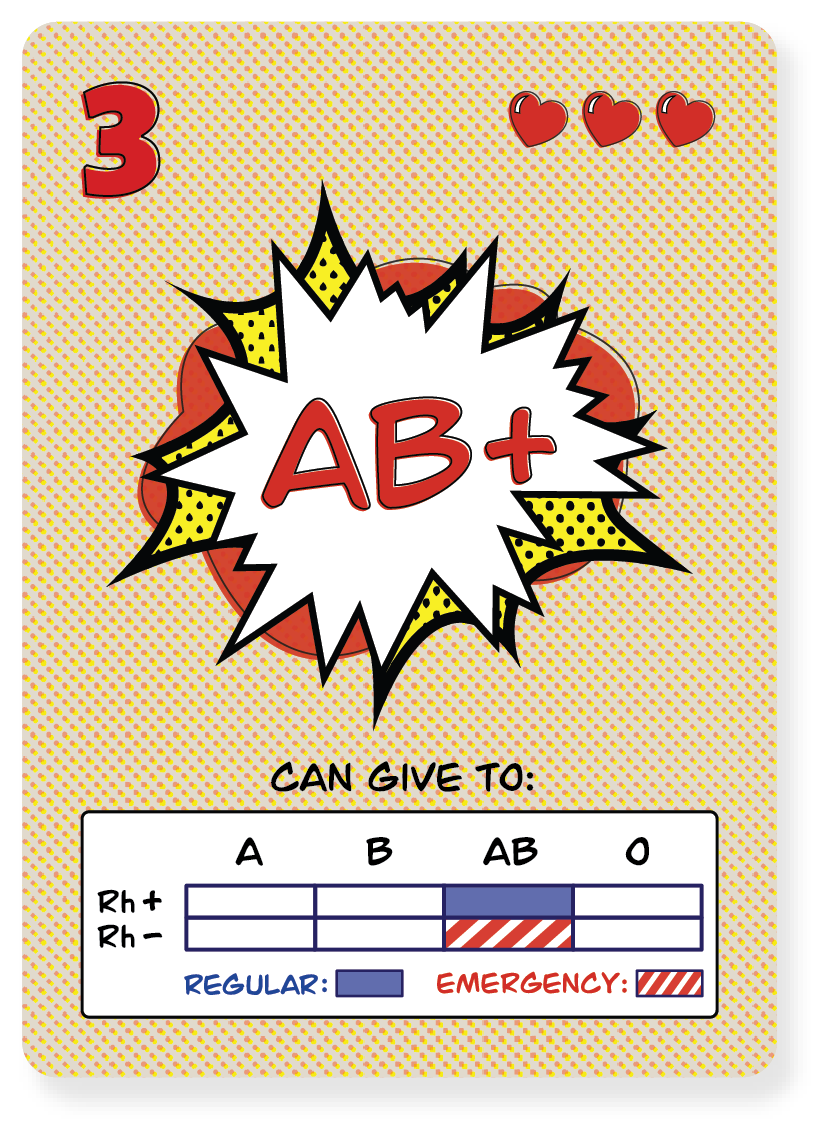REVIVR – CARD GAME
Fun games that teach how blood donations save lives
Illustration, Graphic Design, UX Research, Procreate, Illustrator, Photoshop, LightroomREVIVR™ is a card game that aims to teach about the importance of blood donation. One deck of REVIVR™ can be used to play two games; a standard version titled Blood Feud that’s reminiscent of the game War, and an advanced version titled Revivr, a large group game that simulates the experiences of blood centers and how they navigate blood shortages and life saving.
ABOUT
01 Sketch
✴
02 Prototype
✴
03 Design
✴
04 Refine
✴
05 Produce
✴
01 Sketch ✴ 02 Prototype ✴ 03 Design ✴ 04 Refine ✴ 05 Produce ✴
01 SKETCH
When the CEO of the Oklahoma Blood Institute decided he wanted to make a card game, he reached out to my team to get my help on the project. The ask was to help illustrate assets for a card game that would be both fun and educative for children and adults alike. Not only was his goal to teach about matching blood types, but also about the struggles blood centers face every day. Blood centers are constantly facing shortages from a dwindling supply, so an ulterior goal of this game was to also drive interest to go donate blood through empathy.
To begin the process, he requested I design the wild cards first; superheroes that posses different “powers” to excite players and raise the stakes.
02 PROTOTYPE
Between the sketching and design phase came lots and lots and lots of prototyping. The original direction of the card game was a simple vintage aesthetic. A relaxed color scheme, more straightforward design of the card information, and less decoration. This first round was well received; however, the CEO (the client, in this project) wanted to stay closer to the style of the wild cards. From here, I was able to pivot to a more stimulating look.
During the prototyping phase, it became clear to me that it was imperative that we play the game in order to test it in conjunction with designing it. Therefore, I organized a set to be printed on cardstock so I could print them out to put together a prototype deck by hand.
This helped immensely and guided our decision-making process through the rest of the project.
03 DESIGN
Designing the general card game came next. Following the kind of comic book aesthetic, I decided to head to the library to research the work of Roy Lichtenstein and other 60’s–80’s pop artists. Picking out aspects I enjoyed about the style helped to guide my design process, including half-toning, stippling, slightly “misprinted” outlines, and predominantly primary palettes. These game cards were meant to represent blood types and their corresponding units. Additionally, each card needed a guide at the bottom to assist players in understanding which types could match with others.
04 REFINE
Once we nailed down the game instructions, we sent out a few decks for play testing with different demographics of people; children, adults, blood center employees, high schoolers, and regular folks with no background knowledge on blood donation were all included, so we could get a real feel for how people would play the game. We learned a lot, including that we needed two different designs for the deck boxes and backs, since the advanced version of the game requires players to combine two decks into one. This small addition ended up saving players time and energy, a need we never could’ve predicted until user testing pointed it out.
The refining phase lasted months, crafting and revisiting the instructions over and over again. The intended audience for the game is 6 years old and older, so making sure the voice was simple yet thought-provoking was challenging, especially when discussing scientific principles. With this came the addition of a reference card, to provide players with a quick reference guide to all blood matching possibilities. During this time, I also began designing a website, so curious players and donors could visit to learn more and buy a deck themselves.
05 PRODUCTION
Once we addressed the shortfalls pointed out through user testing, we were ready to move to print. In total, the game was prototyped three times before landing on a final, marketable deck on the fourth round. The website went live and immediately began to see traffic, mostly from blood donors who got the chance to play the game at their blood donation appointments.
Today, the game has been donated to multiple schools around the Oklahoma City area, to be used as a tool to teach students about how to match blood types and the importance of donating blood.
Visit www.revivr.org to learn more about the game and about your role as a blood donor!
06 EDUCATION
It’s one thing to release the game out into the wild– now, we need to teach our audience how to play. I was asked to create an animated How-To video for how to play the advanced version, “Revivr”.
The entire video was produced in After Effects and came out to be over six minutes of animation. I wanted it to be approachable, friendly and an easy watch for players ages 6 years old to 60. I produced this animation from the ground up; script, narration (AI generated voice), animation, soundtrack sourcing, and doodles were all apart of my process.






















